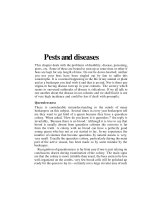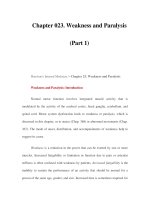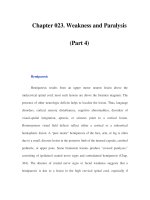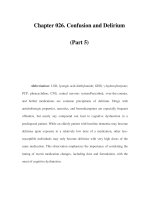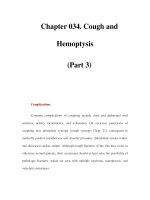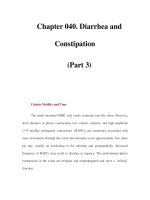Chapter 053. Eczema and Dermatitis (Part 9) pps
Bạn đang xem bản rút gọn của tài liệu. Xem và tải ngay bản đầy đủ của tài liệu tại đây (138.55 KB, 5 trang )
Chapter 053. Eczema and
Dermatitis
(Part 9)
Lichen Planus
Lichen planus (LP) is a papulosquamous disorder that may affect the skin,
scalp, nails, and mucous membranes. The primary cutaneous lesions are pruritic,
polygonal, flat-topped, violaceous papules. Close examination of the surface of
these papules often reveals a network of gray lines (Wickham's striae). The skin
lesions may occur anywhere but have a predilection for the wrists, shins, lower
back, and genitalia (Fig. 53-5). Involvement of the scalp, lichen planopilaris, may
lead to scarring alopecia, and nail involvement may lead to permanent deformity
or loss of fingernails and toenails. LP commonly involves mucous membranes,
particularly the buccal mucosa, where it can present a spectrum of disease from a
mild, white, reticulate eruption of the mucosa, to a severe, erosive stomatitis.
Erosive stomatitis may persist for years and may be linked to an increased risk of
oral squamous cell carcinoma. Cutaneous eruptions clinically resembling LP have
been observed after administration of numerous drugs, including thiazide
diuretics, gold, antimalarials, penicillamine, and phenothiazines, and in patients
with skin lesions of chronic graft-versus-host disease. Additionally, LP may be
associated with hepatitis C infection. The course of LP is variable, but most
patients have spontaneous remissions 6 months to 2 years after the onset of
disease. Topical glucocorticoids are the mainstay of therapy.
Figure 53-5
Lichen planus. An example of lichen planus showing multiple flat-topped,
violaceous papules and plaques. Nail dystrophy as seen in this patient's thumbnail
may also be a feature. (Courtesy of Robert Swerlick, MD; with permission.)
Pityriasis Rosea
Pityriasis rosea (PR) is a papulosquamous eruption of unknown etiology
occurring more commonly in the spring and fall. Its first manifestation is the
development of a 2- to 6-cm annular lesion (the herald patch). This is followed in
a few days to a few weeks by the appearance of many smaller annular or papular
lesions with a predilection to occur on the trunk (Fig. 53-6). The lesions are
generally oval, with their long axis parallel to the skin-fold lines. Individual
lesions may range in color from red to brown and have a trailing scale. PR shares
many clinical features with the eruption of secondary syphilis, but palm and sole
lesions are extremely rare in PR and common in secondary syphilis. The eruption
tends to be moderately pruritic and lasts 3–8 weeks. Treatment is directed at
alleviating pruritus and consists of oral antihistamines, midpotency topical
glucocorticoids, and, in some cases, the use of UV-B phototherapy.
Figure 53-6
Pityriasis rosea. In this patient with pityriasis rosea, multiple round to oval
erythematous patches with fine central scale are distributed along the skin tension
lines on the trunk.
Impetigo, Ecthyma, and Furunculosis
(Table 53-5) Impetigo is a common superficial bacterial infection of skin
caused most often by S. aureus (Chap. 129), and in some cases by group A β-
hemolytic streptococci (Chap. 130). The primary lesion is a superficial pustule that
ruptures and forms a characteristic yellow-brown honey-colored crust (Chap. 130).
Lesions may occur on normal skin—primary infection—or in areas already
affected by another skin disease—secondary infection. Lesions caused by
staphylococci may be tense, clear bullae, and this less common form of the disease
is called bullous impetigo. Blisters are caused by the production of exfoliative
toxin by S. aureus phage type II. This is the same toxin responsible for
staphylococcal scalded-skin syndrome (SSSS), often resulting in dramatic loss of
the superficial epidermis due to blistering. SSSS is much more common in
children than in adults; however, it should be considered along with toxic
epidermal necrolysis and severe drug eruptions in patients with widespread
blistering of the skin.
